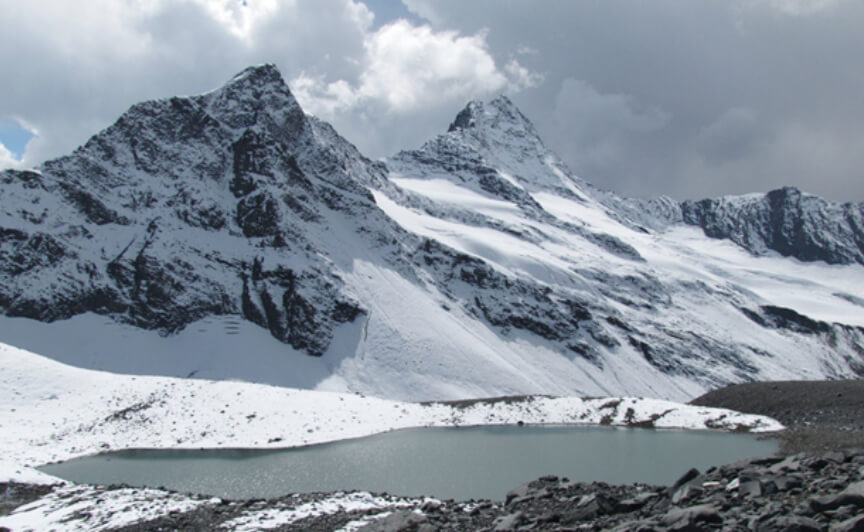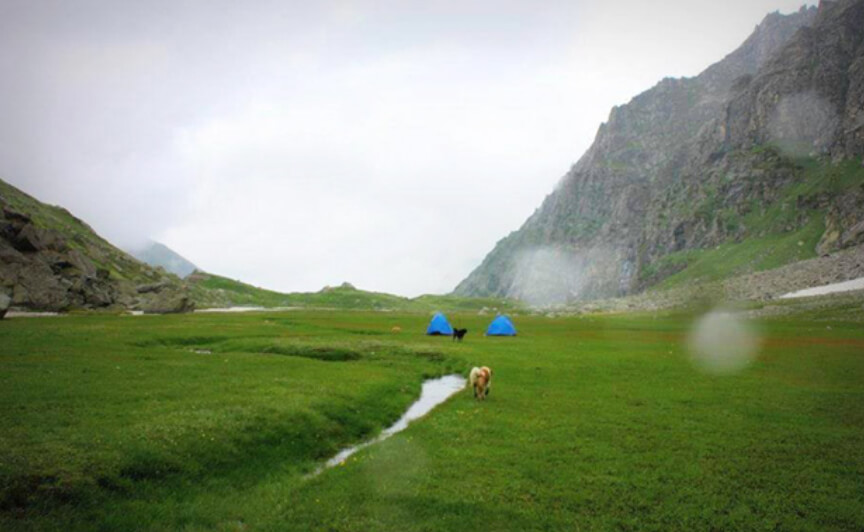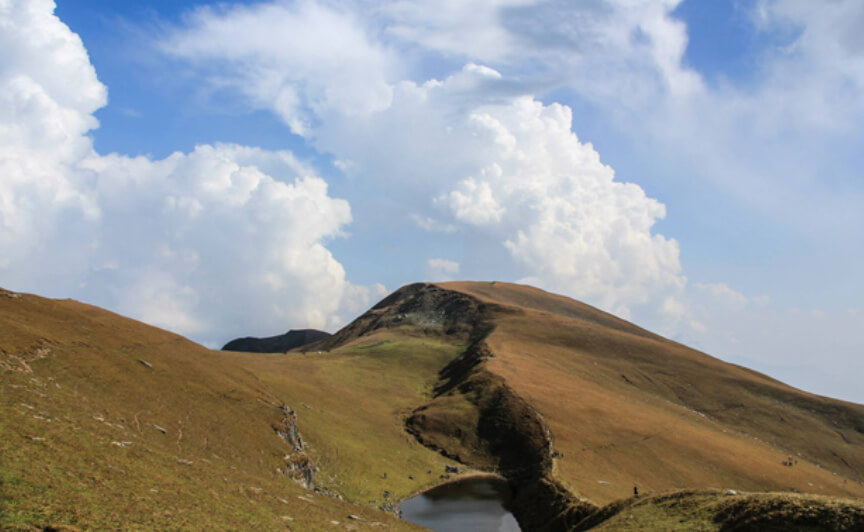






Gateway to Kalihani Pass trek is in Kangra Valley to Manali, the Kalihani Pass sits at an altitude of 15,500 ft. amidst deep wilderness of the majestic Himalayas. The enticing vistas and unending thrills along trekking trails of the Kalihani Pass lures hundreds of trekkers from different corners of the country who come here to explore the hidden charms of this fascinating expedition. Offering breath-taking views of ‘Hanuman Tibba’, ‘Deo Tibba’ and ‘Indrasan’ peaks of the Pir-Panjal Himalayan range, the Kalihani Pass takes you through lush pastures carpeted with vibrant alpine flowers, enchanting valleys, remote villages, dense forests and emerald green meadows. The trek is also a heaven for wildlife enthusiasts and bird lovers who get ample opportunities to have a glimpse of countless Himalayan birds and animals ranging from brown bears, musk deer, snow cocks to a variety of pheasants.
One of the most off the beaten trekking excursions, the Kalihani Pass trek leaves you thrilled and excited as you cross dangerous moraines, gushing streams, steep slopes and snow fed glaciers. Winding your ways through a series of gradual ascents and descents, when you reach the Kalihani Pass, magnificent vistas of Pir-Panjal and Dhauladhar ranges and hanging glaciers greet you with smile; spend some time here basking in the beauty of nature and its work of art.
Conventionally, the Kalihani Pass trek commences from the quaint town of Manali and traverses you through flower-studded meadows of Lamadugh, Riyali Thach finally leading to Kalihani Pass from where the descent starts for Rani Sui, Lamadugh and back to Manali. Awesome beauty of the Himalayas and enchanting trekking trails, will definitely make you attempt this trek once more in your life.
Best time to do the Kalihani Pass Trek is from mid-June to mid-October. Starting phase of the season will bless the trekker with the views of lots of snow at the high passes; the month of August registers a considerable reduction in snow. As the season proceeds, one is likely to witness rain towards Kullu-Manali Valley and sunshine in the Spiti Valley. Days are normally sunny (12–20°C) while the nights are cold, with the temperature at high campsites ranging from -2 to 6°C.
During September to mid-October, the weather is very pleasant. The snow cover on the trail decreases but there is a possibility of snowfall. The days enjoy the lovely presence of sun with temperatures floating between 12 and 18°C. With the onset of October, nights start to get colder (-6 to 4°C).
Kalihani Pass Trek pursues an old shepherd trail between the valleys of Kangra and Kullu in Himachal Pradesh. It starts from Kangra Valley and moves through the dense forests of Giant Deodar, Oak and Alder. Gradually climbing up, the trail takes one to the verdant meadows of Kangra Valley and Kullu Valley. Rhododendron and birch trees make the views more endearing. From the higher meadows of Khanpari one can see the mountain peaks of Kullu and Lahaul.
Normally, after 15th June, or if the snow conditions allow then may be earlier, one can go up to the top of Kalihani Pass (4,797 metres). In the month of September and October, trekking to the top goes from a path which is composed of moraine and ice. The views from the pass are just marvelous. After coming back to the meadows, trek along the ridge to descent on a road head at Lamadung Village.
By evening catch AC train for Pathankot from New Delhi railway station. Overnight journey.
Reception and generous welcome at Pathankot and then we will drive towards Dalhousie. After arriving at Dalhousie check into the hotel and in the evening a small visit for the local sightseeing of the spectacular hill station Dalhousie.
After having the breakfast at Dalhousie we will move forward to explore the Kalatop wildlife sanctuary then head to Khajiyar. Take the pleasure of the exquisite natural beauty of the Mini Switzerland and have lunch here. After having lunch we will head in the direction of Bharmour through Chamba. After arriving at Bharmour you will check into the hotel and later in the evening, join the Aarti at the Chaurasi temples.
In the early morning after having the breakfast and taking the packed lunch, we will trek to the Bharmani Temple. Bharmani temple is located at the crest and is about 3 kilometers trek from Bharmour. In the evening we will come back to Bharmour and check into the hotel for overnight stay.
After having breakfast in the morning the troop will move forward to a small village Holi via taxi a lead of 38 kilometers. Holi is a small and a striking town situated near on the bank of the Ravi River. It is famous for the delicious, red, royal and golden apples and as well as for walnuts. The troop will then pass through Kharamukh, Garola and will stay near the bank of the Ravi River at Choli Bridge to take some rest and enjoyment. Then the troop will move forward in the direction of Holi. Soon after reaching at Holi the troop will visit the small Bazaar of Holi. Then travel to Nayagram and Laakewali Mata 3 kilometers ahead from Nayagram. Lunch will be served in the Laakewali Mata Temple. You will spend the rest day for acclimatization and will stay overnight in the camp.
Laakewali Mata to Dharadi is a 10 kilometers run and it is quite fascinating as the road head ends at the Laakewali Mata. From this point the troop will go downwards for about 500 metres and then will cross a small suspension bridge after that ascend for 1 km and reach at a small village Surie. We will stay for a while at Surie then move forward to Urna village. After crossing a little Nallah close to Urna the trail continues to Khrudu through the ropeway. Khrudu is the destination of merging place of the two pathways, one is through the Bajol village and another is through which we went. After having lunch and relaxing for 1/2 hour at Khrudu the troop will proceed forward through Garonda Village and after crossing the Nala by means of a log overpass locally called ‘Trangdi’ the pathway then climbs steeply for 1 kilometre over a spur to reach the remote village of Dharadi. Dinner & overnight stay will be arranged in the camp.
Dharadi to Lake Camp is a 14 kilometers trek. The trail forwards towards the East crosses steep rock that faces the high above the north side of the Ravi River; there are many tricky and risky sections that need additional and special care. A short rope will prove handy and great use during the trail while on this side of the Ravi River cliffs dominate; the other side is covered with the dense forest. In about 4 to 5 hours we will reach the hamlet of Khanar Village. Then, following a 2 to 3 kilometers journey the path hikes steeply through the wooded slopes to reach the pinnacle of a spur where there are huge conifer trees are seen; it is a traditional resting place for the travelers. The trail is now definite and leads downwards through the trees to a tiny lake encircled by green slopes; this place is a Gaddi shepherds’ encampment, a peaceful and relaxing place after 2 days of tough and tiring trekking through this rock-strewn defile. Although Bara Bhangal is just about 7 to 8 kilometres from here, it is advisable and prudent to camp overnight adjacent to the lake for some rest.
Bara Bhangal is the most remote area of the Kangra Distt. 10 kilometres trek to Bar Bhangal from the lake Base Camp the path ascends for some time and then heads over the extensive grassy meadows. Continuing to the North-East side beside the Ravi River, and an almost level hike ensues to Bara Bhanghal which comes into sight after 8 kilometres. The old village is located a little elevated than the river while the newer one can be seen on the right bank. Bara Bhanghal is a little valley that lies at the base of three towering ranges, and numerous glacier torrents that connect near the village to form the Ravi River. The shepherds’ trails go upwards in all the directions. Nikora Pass (4745 metres) crosses the Manimahesh North to Kugti in the Budhil Valley; the Asha Gali Pass (5033 metres) and Laluni Pass (5438 metres) cross the Bara Bhanghal North-East to Tandi in the Lahaul Valley. The two passes lead towards the east to the Kullu Valley. The Dhauladhar can be crossed to the Kangra Valley by Makori Pass (4605 metres), Gairu Jot (4664 metres) and Thamsar Pass (4624 metres). Arrangements made for comfortable and relaxing camping outside the new village close to the Ravi River.
Day Eight is the entire day for rest at Bara Bhanghal, you can visit both the village visit the local attractions, sightseeing and enjoy the day.
Bara Bhanghal to Devi ki Marhi is about 8 kilometres trek. Early in the morning after having breakfast, the troop will move ahead to the next destination of the journey to Kalihani Pass. The trail now continues to the upstream beside the Ravi River into the deodar forest. After reaching Marhi, we will establish the camp and will rest here for the night.
After having the breakfast we will move towards the other destination of the trek ‘Devi Ki Marhi’. Starting the trek of the day, though it is a steep downwards trek after departing the Dal Marhi camp site. However, most of pathway is flat with a few ups and downs. Then the trek will pass through the dense oak and birch forests, further crosses the Kalihani Nallah and finally reach at the Devi ki Marhi campsite.
Devi ki Marhi to the Base Camp is 4 kilometres trek. Some peoples directly go to cross the pass. But that is a very long journey. To reach the destination we will trek in parts to ensure the safety of the trekkers and not trying to exhaust their energy to tier them. So we will move ahead after the breakfast from Devi ki Marhi. A steep climb across the glacier and the stunning glacial lakes soon will bring you to the campsite at the Base Camp.
The Alyas Base camp situated to the other side base camp over the Kalihani Pass trek totally depends upon the climatic conditions and the physical condition of the trekker. Generally the Tour Guide will not take the danger or give permit to start the trek in very bad weather condition and will wait until the sky clear up.
If later the sunshine, then after having a light breakfast and taking along the packed lunch we will begin to move ahead in the early morning around 5:00 AM, to make certain that the snow is outright frozen for a less difficult hike and require to cross the pass before 12:00 to 01:00 PM or otherwise it will create major problems as rainfall, heavy snow, winds, and even snow fall can take place any time.
So, early in the morning after having a light breakfast the troop will move forward prepared for a day full adventurous and enjoyable. We will start early in the early morning as the frozen snow makes it for better and easier to walk on a well trodden outline. The climb between two parallel ridges becomes tricky as the height is increased over the snow slopes to enter the upper glacier. From about 3 kilometres from the camp site we will pass a glacial lake. Terrible snow conditions higher up will make advance quite troublesome. Two small peaks, Thamsar (5078 metres) and Lantern (5067 metres) can easily be seen on the other side of the pass. You can get spectacular 360 degree panoramic views of the hanging glaciers, the Dhauladhar and Pir Panjal ranges during the trek.
After having the breakfast we will move towards Riyali. The trail from here will proceed over to the open extensive meadows initially, followed by a precipitous going down to a stream. After crossing the stream, the path will further continue for a steep climb for around 3 hours till you reach at the Riyali. Make sure that you capture the fabulous views of the Deo Tibba and Indrasan peaks in your camera from the camp site you left behind.
Today we will start the trek after the breakfast. The height is steep decent, you can see the distinct views of the Deo Tibba, Indrasan, and the peaks of Bara Shigri glacier on the way during trekking. On the trail you will come across dissimilar types blossoming alpine flowers. After starting the trail, the path turns to the right direction and one pass through the ridge horizontally and then enters the camp site on an alpine plateau studded with dense growth of the alpine flowers. From this point, you can have the wonderful glimpse of the Manali hill station, located on the left bank of the River Beas and the entire upper Kullu valley, which appears incredible swathed in the various vibrant colors of the season.
In the early morning we will move in the direction of Manali hill station. Keep the water in the bottle filled as in the way there is no water point. After arrival at Manali the last destination of the trek, transfer to Volvo station and from here drive to Delhi by AC Volvo coach. Overnight journey.
Arrival at Delhi by morning.

An experienced trekking tour operator, with a team of an experienced adventure enthusiast ensure to give our clients well-designed trekking tour packages.

We are certified by major tour and travel associations in India and world like IATA, IATO, TAAI, IMF & MOT (Ministry of Tourism, Govt of India).

TMI has received numerous accolades from its happy customers for its excellent services and best adventure holidays.

We have local office in Ladakh, Uttarakhand, Sikkim, Jammu & Kashmir, & Himachal Pradesh for our customers to find assistance anytime and anywhere.